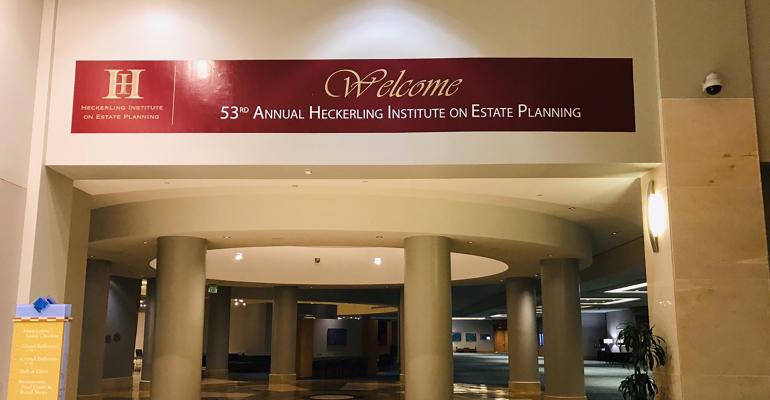In the opening Fundamentals Program at the 2019 Heckerling Institute on Estate Plannjng, Lester B. Law, a member of Franklin Karibjanian & Law PLLC in Naples, Fla., and Howard M. Zaritsky, a nationally recognized estate-planning expert in Rapidan, Va., presented their thoughts on “Basis After the 2017 Tax Act—Important Before, Crucial Now.” Lester and Howard focused on where you can create basis—particularly in places where you don’t necessarily expect to find it—and touched on several important issues practitioners face after the 2017 Tax Act. Here are some of their highlights.
Proving Basis
When in doubt, report! There are never penalties for overreporting income—but the penalties for underreporting can be severe. Even though clients may not want you to do what they perceive as “extra work”—it’s not their call. So, err on the side of overreporting.
Due to the increased exemptions in the 2017 Tax Act, many practitioners have become income tax planners rather than estate tax planners. Unfortunately, clients often don’t know what their basis is in their properties. Advise clients to keep good records of the cost of their properties. Under the Cohan rule, taxpayers and the Internal Revenue Service can approximate basis in the absence of original documents that may otherwise establish absolute proof. Thus, if a client provides even some information as to what the value of his property is, that’s enough to shift the burden to the Internal Revenue Service to ascertain the property’s basis.
Keep in mind that if there’s a court proceeding, under Internal Revenue Code Section 7491, the taxpayer has the burden to produce some credible evidence of basis. Once he’s complied, however, the burden shifts to the IRS to ascertain basis. Both Howard and Lester stressed that if you think your client will be involved in litigation and has some measure of basis to offer, it’s important to “educate” the IRS agent on the burden of proof under IRC Section 7491. Many agents indicate they will assign zero basis to property—but, that’s not the law.
Basis, Portability and the CST
Although portability has been around for about a decade, the concept has proven more complicated for practitioners, given the increased exemptions. There are many reasons to use portability; in terms of planning for your clients, it’s typically best to start with a portability-type plan as the default plan. Such a plan will almost always be superior to a non-portability-type plan (typically due to portability’s double basis step-up).
There are some clients, however, who don’t want to use portability and instead want to use a traditional, non-marital credit shelter trust (CST). If that’s the case, there are four mechanisms you can suggest to get a basis step-up adjustment on the second spouse’s death:
- Independent trustee power of distribution: This is a “simple” mechanism, according to Lester and Howard, but it needs to be “thoughtful.” You can use an independent trustee and give him broad authority to make distributions from the CST to the surviving spouse. If the amount doesn’t exceed the surviving spouse’s exclusion, the distribution won’t trigger federal estate taxes. The distributed property, however, will become part of the surviving spouse’s estate for federal estate tax purposes and will be considered to have been acquired from the decedent (who’s now the second spouse to die). This mechanism has several benefits: the trustee has flexibility to pick and choose which asset to distribute, and it’s easily understandable by clients. However, one risk is that it’s difficult to figure out the right timing of a distribution. Clients aren’t always honest about their health, so it’s often hard to find the ideal time for distributing appreciated property (which is the time close to the death of the surviving spouse). Moreover, there’s also a risk of exposing the property to creditors.
- Contingent general power of appointment (GPOA): Grant the surviving spouse a contingent GPOA, but this will cause inclusion in the surviving spouse’s estate for federal estate tax purposes. If the surviving spouse exercises a testamentary GPOA, the property passing is considered to have been passed from the now-deceased surviving spouse; the general basis adjustment rule under IRC Section 1014(b)(4) applies. Draft a GPOA only for appreciated assets. Then, you preserve losses for future gains. You can also suggest bifurcating appreciating assets (for example, artwork) and within the bifurcation, stratify those assets. Consider how soon the asset is going to be sold. It’s hard to determine for sure when an asset will be sold—even clients themselves may not know when an asset will be sold.
- Trust protector with an ability to create a GPOA: Suggest granting an independent trustee or trust protector the authority to grant the surviving spouse a GPOA. The trust protector can choose which asset the surviving spouse will have a GPOA over. And, the trust protector can modify the GPOA, as long as the spouse is still alive. There are risks to this mechanism, however, such as the potential for creditors to reach property over which the decedent had a GPOA.
- Delaware tax trap: This mechanism is complicated to explain to clients, and it may not work in certain states. This is Lester’s and Howard’s least favorite option, as it’s hard to execute and difficult to understand. The Delaware tax trap is a way of having a limited POA taxed as a GPOA without it actually being a GPOA. In many states, you can spring the Delaware tax trap if you exercise a POA over a trust in which the beneficiary of the new trust has a current right to appoint himself. A problem is if a state has abolished or repealed the Rule Against Perpetuities, and it’s unclear whether you can spring the trap.





